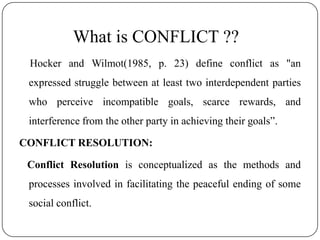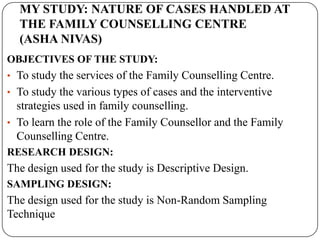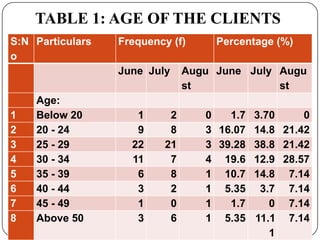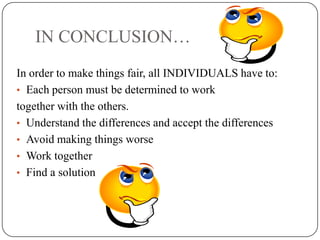Aarthi grace
- 1. FAMILY & CONFLICT RESOLUTION PRESENTED BY: GRACE BERYL CAROLINA.D & AARTHI V.S. II M.S.W STELLA MARIS COLLEGE
- 2. FAMILY ‘Some families are nurturing places where people learn about their abilities, practice giving and receiving love, and dare to dream what they might become. ‘Some families are prisons where people do what they are told and wait long years for a word of appreciation or agitate for an opportunity to escape.’ - Miller
- 3. What makes the Difference ?? ‘The way a family communicates. A word or a look can lock someone in their world as turning a key. Yet the key that opens the possibilities of your World is still a look or a word. The difference ? – Effective Communication.’ - Miller
- 4. What is CONFLICT ?? Hocker and Wilmot(1985, p. 23) define conflict as "an expressed struggle between at least two interdependent parties who perceive incompatible goals, scarce rewards, and interference from the other party in achieving their goals”. CONFLICT RESOLUTION: Conflict Resolution is conceptualized as the methods and processes involved in facilitating the peaceful ending of some social conflict.
- 5. What Causes Conflict ?? Perceived breach of faith and trust. There is unresolved disagreement between individuals that has escalated to an emotional level. Miscommunication. Grrrrr….. There are personality clashes. Differences in acquired values. Grrrrr…..
- 6. COMMON REASONS FOR FAMILY DISPUTES AS OBSERVED TODAY: Provocations and hurting each other by taunts, sarcasms Wife battering, dowry, bride burning; Violent behaviour of either spouse more often than not the husbands; Use of alcohol and drug abuse are also important factors; In many parts of India the question of dowry or promised dowry becomes a point of wrangling between the spouses. The situation may be further worsened or aggravated by needless interference from in-laws; Extra marital relations by either spouse or promiscuity; Doubting the integrity/ character of spouse (by either spouse).
- 7. THE NEED FOR FAMILY COUNSELLING CENTRES : • In India, in the wake of increased family disputes, divorces, family violence, dowry harassment and family maladjustments some support systems came into existence to help the victims and the aggrieved parties. This gave rise to introduction of family courts and the concept of Family Counselling Centres. • STUDY FOCUSES ON THE NATURE OF CASES HANDLED AT THE FAMILY COUNSELLING CENTRE, ASHA NIVAS (Office of the Commissioner of Police)
- 8. MY STUDY: NATURE OF CASES HANDLED AT THE FAMILY COUNSELLING CENTRE (ASHA NIVAS) OBJECTIVES OF THE STUDY: • To study the services of the Family Counselling Centre. • To study the various types of cases and the interventive strategies used in family counselling. • To learn the role of the Family Counsellor and the Family Counselling Centre. RESEARCH DESIGN: The design used for the study is Descriptive Design. SAMPLING DESIGN: The design used for the study is Non-Random Sampling Technique
- 9. TABLE 1: AGE OF THE CLIENTS S:N Particulars Frequency (f) Percentage (%) o June July Augu June July Augu st st Age: 1 Below 20 1 2 0 1.7 3.70 0 2 20 - 24 9 8 3 16.07 14.8 21.42 3 25 - 29 22 21 3 39.28 38.8 21.42 4 30 - 34 11 7 4 19.6 12.9 28.57 5 35 - 39 6 8 1 10.7 14.8 7.14 6 40 - 44 3 2 1 5.35 3.7 7.14 7 45 - 49 1 0 1 1.7 0 7.14 8 Above 50 3 6 1 5.35 11.1 7.14 1
- 10. TABLE 2: SEX OF THE CLIENTS: S:N Particulars Frequency (f) Percentage (%) o: June July Augu June July Augu st st Sex: 1 Male 4 6 3 7.14 11.11 21.42 2 Female 52 48 11 92.85 88.88 78.57 TOTAL 56 54 14 100 100 100
- 11. TYPE OF FAMILY
- 12. TABLE 3: COMMUNITY OF THE CLIENTS S:N Particulars Frequency (f) Percentage (%) o: June July Augu June July Augus st t Place: 1 Urban 38 37 7 67.85 68.51 50 2 Sub-Urban 20 21 6 35.71 38.8 42.85 3 Rural 1 1 1 1.78 1.85 7.14 TOTAL 56 54 14 100 100 100
- 13. TABLE 4 : EDUCATIONAL QUALIFICATION OF THE CLIENTS S:N Particulars Frequency (f) Percentage (%) o: June July Augu June July Augus st t Educational Qualification: 1 Illiterate 4 6 1 7.14 11.11 7.14 2 Below +2 15 23 5 26.7 42.5 35.7 3 +2 12 2 1 21.42 3.70 7.14 4 Graduate 15 8 5 26.7 14.8 35.7 5 Post Graduate 6 6 1 10.7 11.11 7.14 6 Engineer 1 5 0 1.7 9.25 0 7 Diploma 3 4 1 5.35 7.40 7.14 TOTAL 56 54 14 100 100 100
- 14. NATURE OF CASES: Dowry Demand Personality Differences Love Affair/Unwed Property Dispute Mothers Extra Marital Affair Sexual Problem Substance Abuse/Harassment Unemployment/Economic Paranoid Tendency Crisis Bigamy Mal- Adjustment with In Laws Sexual Abuse Problem by Spouse & In Desertion laws Mental Illness Mal Adjustment with Parents & Children Mal Adjustment With Spouse
- 15. TABLE 5: ASSISTANCE RENDERED AT THE FAMILY COUNSELLING CENTRE S:No Particulars : 1 Counselling 2 Referred to Legal Aid 3 Family Court 4 Protection Officer 5 Psychiatric Help 6 Short Stay Homes 7 De-Addiction Centre’s 8 Sex Therapist 9 Civil Supply Office 10 Police Assistance
- 16. SUGGESTIONS AND FINDINGS The findings revealed the varied nature of cases handled by the counsellors at the Family Counselling Centre. The cases reveal that women bore the brunt of marital conflict as a result of violence, dowry harassment, desertion etc. • It was also noted that majority of the cases that were referred at the counselling centre, were at a point were reunion was impossible; that is, the time gap of separation was long or simple misunderstandings had grown into huge heaps of misconceptions. Hence, efforts should be taken to give importance to pre-marital counselling, as it would enable couples to face reality than raking up petty issues, thereby landing up in separation or divorce.
- 17. SUGGESTIONS AND FINDINGS The findings also revealed that a majority of physical harassment on the women was due to the demanding of unmet dowry needs that was often instigated upon the man by his parents. Family Counselling Centres can become a moral support system in our society, which is standing witness to the ever increasing divorce rates of young couples. These centres can ensure and provide ample guidance for couples who are having a constrained relationship between themselves, thereby giving vent for couples to reconsider and reunite.
- 18. IN CONCLUSION… In order to make things fair, all INDIVIDUALS have to: • Each person must be determined to work together with the others. • Understand the differences and accept the differences • Avoid making things worse • Work together • Find a solution
- 19. THANK YOU PRESENTED BY: GRACE BERYL CAROLINA. D AND V.S. AARTHI II M.S.W STELLA MARIS COLLEGE



















